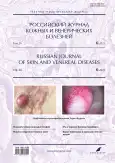Human papillomavirus and its association with oral lichen planus
- Authors: Starshinina V.A.1, Perlamutrov Y.N.1, Olhovskaya K.B.1
-
Affiliations:
- Moscow State University of Medicine and Dentistry named after A.I. Evdokimov
- Issue: Vol 26, No 6 (2023)
- Pages: 645-652
- Section: DERMATOLOGY
- URL: https://journals.rcsi.science/1560-9588/article/view/254774
- DOI: https://doi.org/10.17816/dv611050
- ID: 254774
Cite item
Abstract
BACKGROUND: Oral lichen planus is a chronic disease with periods of exacerbations and remissions, requiring long-term symptomatic treatment and observation. Dermatosis can occur or worsen in the presence of different triggers, for example, due to the persistence of the human papillomavirus.
AIM: to explore the effect human papillomavirus on the characteristics oral lichen planus.
MATERIALS AND METHODS: 90 patients with oral lichen planus aged from 26 to 73 years (average age 55.61±1.00 years) were examined. Real-time polymerase chain reaction was used to detect human papillomavirus. The need for treatment of caries, Green–Vermillion and complex periodontal indices were used to analysis state of oral hygiene.
RESULTS: Human papillomavirus DNA was detected in 53 (58.88%) cases. Patients of this group were 4 years younger than other study participants; the duration of dermatosis is 2 years longer with a predominance of atrophic/erythematous and erosive/ulcerative forms. It was noted that indexes of caries and the complex periodontal were significantly (p=0,007 and p=0,030 respectively) higher compared to patients without papillomavirus infection.
CONCLUSION: It is found features of oral lichen planus in identifying human papillomavirus: early onset; severe of the disease with predominantly destructive forms; high prevalence of caries and periodontitis.
Full Text
##article.viewOnOriginalSite##About the authors
Victoria A. Starshinina
Moscow State University of Medicine and Dentistry named after A.I. Evdokimov
Author for correspondence.
Email: starshinina_v@rambler.ru
ORCID iD: 0000-0001-5171-268X
SPIN-code: 6427-4162
Graduate Student
Russian Federation, 103 Mira avenue, 129085 MoscowYuri N. Perlamutrov
Moscow State University of Medicine and Dentistry named after A.I. Evdokimov
Email: mgmsu-skin@mail.ru
ORCID iD: 0000-0002-4837-8489
SPIN-code: 2330-2758
MD, Dr. Sci. (Med.), Professor
Russian Federation, 103 Mira avenue, 129085 MoscowKira B. Olhovskaya
Moscow State University of Medicine and Dentistry named after A.I. Evdokimov
Email: olhovskaya_kira@mail.ru
ORCID iD: 0000-0003-4920-5288
SPIN-code: 9455-9482
MD, Cand. Sci. (Med.), Associated Professor
Russian Federation, 103 Mira avenue, 129085 MoscowReferences
- Vijayan A, Muthukrishnan A, Vidyadharan M, Nair A. Role of human papilloma virus in malignant transformation of oral lichen planus: A systematic review. J Pharmacy Bioallied Sci. 2021;13(Suppl 1): 62–S67. doi: 10.4103/jpbs.jpbs_836_20
- Villa TG, Sánchez-Pérez Á, Sieiro C. Oral lichen planus: A microbiologist point of View. Int Microbiol. 2021;24(3):275–289. doi: 10.1007/s10123-021-00168-y
- Sabirov TK, Sultonov UB. Clinical course of lichen planus. Dermatovenerol Aesthetic Med. 2022;(1-2):10–13. (In Russ).
- Sood A, Raghavan S, Batra P, et al. Rise and exacerbation of oral lichen planus in the background of SARS-COV-2 infection. Med Hypotheses. 2021;(156):110681. doi: 10.1016/j.mehy.2021.110681
- Zou H, Daveluy S. Lichen planus after COVID-19 infection and vaccination. Arch Dermatol Res. 2022;315(2):139–146. doi: 10.1007/s00403-022-02497-y
- Galchenko VM. Treatment of complex forms of red flat lichen of the mucous membrane of the cavity. In: The role of science and education in the modernization of modern society: collection of articles of the International Scientific and Practical Conference (December 19, 2019, Orenburg). Part 2. Ufa: Aeterna; 2019. Р. 211–214. (In Russ).
- Shang Q, Peng J, Zhou Y, et al. Association of human papillomavirus with oral lichen planus and oral leukoplakia: A meta-analysis. J Evid Based Dental Pract. 2020;20(4):101485. doi: 10.1016/j.jebdp.2020.101485
- Oberti L, Alberta L, Massimo P, et al. Clinical management of oral lichen planus: A systematic review. Mini Rev Med Chem. 2019;19(13):1049–1059. doi: 10.2174/1389557519666190301144157
- Swain SK. Premalignant lesions of the oral cavity: Current perspectives. J Res Med Sci. 2021;9(6):1816. doi: 10.18203/2320-6012.ijrms20212259
- Wang J, Yang J, Wang C, et al. Systematic review and meta-analysis of oxidative stress and antioxidant markers in oral lichen planus. Oxid Med Cell Longev. 2021;2021: 9914652. doi: 10.1155/2021/9914652
- Mohammadi M, Abbaszadeh H, Mohtasham N, et al. The association between high-risk human papillomavirus and oral lichen planus. Clin Exp Dent Res. 2023;9(1):93–99. doi: 10.1002/cre2.707
- Didona D, Caro RD, Santos AM, et al. Therapeutic strategies for oral lichen planus: State of the art and new insights. Front Med. 2022;(9):997190. doi: 10.3389/fmed.2022.997190
- Gileva OS, Koshkin SL, Libik TV, et al. Periodontological aspects of diseases of the oral mucosa: lichen planus. Periodontology. 2017;22(3):9–14. (In Russ).
- Shang Q, Peng J, Zhou Y, et al. Association of human papillomavirus with oral lichen planus and oral leukoplakia: A meta-analysis. J Evid Based Dent Pract. 2020;20(4):101485. doi: 10.1016/j.jebdp.2020.101485
- Elenbaas A, Enciso R, Al-Eryani K. Oral lichen planus: A review of clinical features, etiologies, and treatments. Dent Rev Dent Clin Dent Prospects. 2022;2(1):100007. doi: 10.1016/j.dentre.2021.100007
Supplementary files







